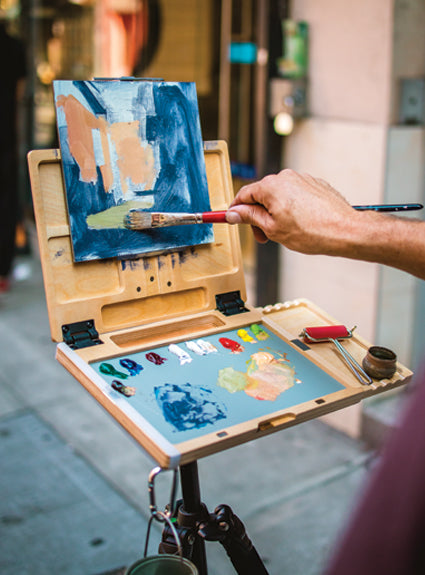INTERVIEW with BRANDON SOLOFF

WHERE DO YOU LIVE AND WORK?I currently live and work in New York, NYTELL US ABOUT YOUR PAINTING CAREER.I'm a classically trained oil painter focusing on the human figure and portraits.
In addition to being one of the founders of Chelsea Classical Studio Fine Art Materials, I teach at Chelsea Classical Studio and The Art Students League. In the past I've taught at The National Academy, Studio126 (co-founded with Michael Grimaldi), workshops at The Academy of Classical Design, The Washington Art Association and others since around 2002.
I've exhibited since the late 1990s, including Hirschl & Adler Gallery (New York, NY), Alan Stone Gallery (New York, NY), Hammer Galleries (New York, NY), The Royal Society Portrait Painters (London, England), Meredith Long Galleries (Houston, TX), The Copley Society of Boston (Boston, MA) and others.
Portrait commissions for institutions such as Dartmouth University and Westmont College, as well as Frederick Whittemore (Morgan Stanley), David H. Koch Jr. (David Koch Family), Paul Raether (Kohlberg, Kravitz and Roberts),Didier Pineau-Valencienne (Schneider Industries Europe) and others.

WHAT IS YOUR EDUCATIONAL BACKGROUND IN THE ARTS?After graduating high school in 1991 I went to Florence, Italy for 3 years. I studied at Charles Cecil Studios and 1 year at Haverford College somewhere in the middle :-).
Afterwards I shared a studio for 6 months in Boston with Charles Weed and Frank Strazzulla, two impressive artists with different temperaments and aesthetics.
I then studied privately in North Carolina with D. Jeffrey Mims for 2 years (he since created the Academy of Classical Design).
I apprenticed on a Ben Long fresco project for Transamerica in Charlotte NC.
Also spent 6 months with Martine Vaugel, a sculptor whose teaching really helped to address structural, depth and volume issues that painters often ignore. I studied various short stints with artists such as Stephen Perkins and Frank Porcu (anatomy, sculpture and ecorche work), and a few months at Water Street Atelier.
I independently spent many many months copying original drawings and paintings in Boston (Fogg, MFA), London (British Museum, V&A), and Paris (Louvre, Henner).
Basically spent the 1990’s studying and traveling…..
WHAT IS A LITTLE KNOWN FACT YOU WOULD LIKE TO SHARE ABOUT YOURSELF?
My grandfather was a bootlegger

YOU'VE STUDIED UNDER A NUMBER OF ARTISTS IN THE US AND EUROPE. HOW HAVE DIFFERENT METHODS SHAPED YOUR APPROACH TO PAINTING? I don’t work specifically in a way I was taught at one place, but certainly every place I studied was formative and influential.
Rather than going to an art college, I studied at ateliers and directly with other painters and sculptors, because I wanted to decide who I studied with and for how long. The teachers were all knowledgeable but all had very different working methods and things they believed, which at times was difficult to reconcile, but in the end very enriching.
Charles Cecil focused on sight-size, art history and really inspired people to respect and appreciate oil painting; D. Jeffrey Mims stressed composition, design, taking your time to look for ways to make each aspect better, and to be critical of what you are doing to improve over the long term; Ben Long is an impressive expressive draughtsman who studied extensively with Annigoni, and watching and helping on the fresco as it developed from sketches to completion was a real education. The other artists and teachers gave a lot of perspective on things, and the independent museum work really created appreciation for not just the quality of paintings, but also how varied and rich painting is, and how each painter evolved over time as they developed.
The best teachers, I feel in retrospect, were the ones that pushed the students to become autodidactic and learn how to work on their own. The skill to become independent and develop beyond the classroom is in keeping with the tradition of artists we admire whose work evolved greatly throughout their lives as their interests and influences directed them to learn new things. When comparing the early to late work of artists such as Rembrandt, Michelangelo, Velazquez etc.- it becomes clear they were not just a product of their education but made themselves exceptional over time.

HAVE YOU ALWAYS BEEN CURIOUS ABOUT THE MATERIALS YOU USE?In Florence, the teacher and students generally were very interested in grinding our own paints, discussing mediums and techniques. So from the age of 18 I was introduced to texts and discussions about materials. Over the years I experimented with making and using different materials, mostly out of curiosity and dissatisfaction with the materials available at the stores. I would sometimes give materials workshops at the Art Students League. When I started teaching together with other artists at Chelsea Classical Studio like Rick Piloco, we would often talk shop and it seemed that a lot of materials we used were things we made ourselves or were hard to find, especially the naturally cleaned Linseed oil and alternative solvents. So eventually we put things together and started a small artist-run oil painting materials company: Chelsea Classical Studio Fine Art Materials.

TELL US ABOUT A FEW OF YOUR FAVORITE CCS PRODUCTS?
We specialize in naturally cleaned oils and alternative solvents such as Linseed Oil, Walnut Oil, and Spike Oil Solvent. Our mediums and varnishes use these as the principal ingredients. We also produce brush cleaning solvents.
We spend a lot of time on our Linseed to make it pale, more bodied and faster drying, so I am partial to it.
The Spike works really well, and we like the smell of it compared to Turpentine or Petroleum (as well as not getting headaches).

IF SOMEONE WANTED TO LEARN MORE ABOUT CHELSEA CLASSICAL STUDIO (SCHOOL OR PRODUCTS), WHERE SHOULD THEY GO?On the site we try and explain everything as clearly as possible, and welcome peoples’ questions if they have them. www.chelseaclassicalstudio.com









